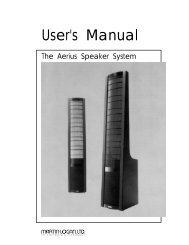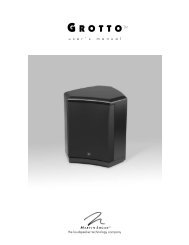M o n t i s - MartinLogan
M o n t i s - MartinLogan
M o n t i s - MartinLogan
Create successful ePaper yourself
Turn your PDF publications into a flip-book with our unique Google optimized e-Paper software.
Dispersion InteractionsControlled Horizontal DispersionYour Montis’s launch a 30 degree horizontal dispersion pattern.This horizontal dispersion field gives a choice of good seats for theperformance while minimizing interactions with side walls (seefigure 9). Make sure both speakers stand exactly at the same verticalangle, otherwise the image can be skewed or poorly defined.The wave launch of both speakers is extremely accurate in boththe time and spectral domain. Consequently, small refined adjustmentscan result in noticeable sonic improvements.Controlled Vertical DispersionAs you can see from the illustrations, your Montis speakers projecta controlled dispersion pattern (see figure 10). Each Montisis a 44 inch line source beginning 13.75 inches above the base.This vertical dispersion profile minimizes interactions with thefloor and the ceiling.Three Major Types of DispersionIt is a known fact that as the sound wave becomes progressivelysmaller than the transducer producing it, the dispersionof that wave becomes more and more narrow, or directional.This fact occurs as long as the transducer is a flat surface. Largeflat panel speakers exhibit venetian blind effects due to thisphenomenon. This is one reason why many manufacturers optfor small drivers (i.e. tweeters and midrange) to approximatewhat is known as a point source wave launch.Historically, most attempts to achieve smooth dispersion fromlarge flat panel transducers resulted in trade-offs. After exhaustivetesting of many different methods, we conceived anelegantly simple, yet intensely hand crafted process. By curvingthe radiating surface, we create the effect of a horizontal arc.This allows the engineers at <strong>MartinLogan</strong> to control the high frequencydispersion pattern of our transducers.Figure 5–6. As can be seen here, point sourceconcepts invite a great deal of room interaction.While delivering good frequency response to alarge listening audience, imaging is consequentlyconfused and blurred.Figure 7–8. Even though they suffer from“venetian blind” effect, angled multiple panelspeakers can deliver good imaging, but onlyto specific spots in the listening area.EnglishFigure 9–10. A controlled 30 degree cylindricalwave-front, a <strong>MartinLogan</strong> exclusive, offersoptimal sound distribution with minimal roominteraction. The result is solid imaging with awide listening area.Dispersion Interactions 29






